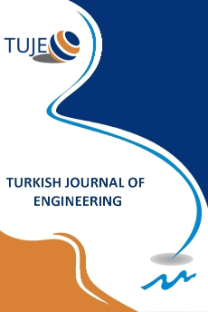Collapse capacity assessment of non-ductile open ground story reinforced concrete frame
Collapse capacity assessment of non-ductile open ground story reinforced concrete frame
___
- Asteris, P. G. (2003). Lateral Stiffness of Brick Masonry Infilled Plane Frames. Journal of Structural Engineering, American Society of Civil Engineers (ASCE), 129(8), 1071–1079. https://doi.org/10.1061/(ASCE)0733-9445(2003)129:8(1071)
- Cavaleri, L. & Di Trapani, F. (2014). Cyclic response of masonry infilled RC frames: Experimental results and simplified modeling. Soil Dynamics and Earthquake Engineering, 65, 224–242. https://doi.org/10.1016/j.soildyn.2014.06.016
- Comite Euro-International du Beton (CEB) (1996). RC Frames Under Earthquake Loading: State of the Art Report. Thomas Telford, London, UK.
- Dolšek, M., & Fajfar, P. (2008). The effect of masonry infills on the seismic response of a four storey reinforced concrete frame-a probabilistic assessment. Engineering Structures, 30(11), 3186–3192. https://doi.org/10.1016/j.engstruct.2008.04.031
- Hashemi, A., & Mosalam, K. M. (2006). Shake-table experiment on reinforced concrete structure containing masonry infill wall. Earthquake Engineering and Structural Dynamics, 35(14), 1827–1852. https://doi.org/10.1002/eqe.612
- Mehrabi, A. B, Shing, P. B., Schuller, M. P., & Noland, J. L. (1996). Experimental Evaluation of Masonry-Infilled RC Frames. Journal of Structural Engineering, 122(3), 228–237. https://doi.org/10.1061/(ASCE)0733-9445(1996)122:3(228)
- Negro, P. & Verzeletti, G. (1996). Effect of infills on the global behaviour of R/C frames: Energy considerations from pseudodynamic tests. Earthquake Engineering and Structural Dynamics, 25(8), 753–773. https://doi.org/10.1002/(SICI)1096-9845(199608)25:8<753::AID-EQE578>3.0.CO;2-Q
- Dolšek, M., & Fajfar, P. (2001). Soft storey effects in uniformly infilled reinforced concrete frames. Journal of Earthquake Engineering, 5(1), 12. https://doi.org/10.1080/13632460109350383
- Negro, P., & Colombo, A. (1997). Irregularities induced by nonstructural masonry panels in framed buildings. Engineering Structures, 19(7), 576–585. https://doi.org/10.1016/S0141-0296(96)00115-0
- Akın, E. (2019). Open ground story in properly designed reinforced concrete frame buildings with shear walls. Structures, 20, 822-831. https://doi.org/10.1016/j.istruc.2019.07.003
- Eurocode 8 (2005). European Standard EN 1998-3:2005: Design of structures for earthquake resistance - Part 3: Assessment and retrofitting of buildings. Comite Europeen de Normalisation, Brussels, Belgium.
- TEC (2018). Turkish Earthquake Code for Buildings. Republic of Turkey Prime Ministry Disaster and Emergency Management Authority, Ankara, Turkey.
- SeismoStruct (2020). A computer program for static and dynamic nonlinear analysis of framed structures. Seismosoft Ltd. https://seismosoft.com
- Kadaş, K. (2006). Influence of idealized pushover curves on seismic response. MSc Thesis, Middle East Technical University, Graduate School of Natural and Applied Sciences, Ankara, Turkey, 320p.
- Mander, J. B., Priestley, M. J. N., & Park, R. (1988). Theoretical Stress‐Strain Model for Confined Concrete. Journal of Structural Engineering, 114(8), 1804–1826. https://doi.org/10.1061/(ASCE)0733-9445(1988)114:8(1804)
- Martínez-Rueda, J. E., & Elnashai, A. S. (1997). Confined concrete model under cyclic load. Materials and Structures, 30(3), 139–147. https://doi.org/10.1007/BF02486385
- ACI (American Concrete Institute) (2008). Building code requirements for structural concrete (ACI 318M-08) and Commentary. Farmington Hills, MI, USA.
- American Society of Civil Engineers (ASCE) (2000). Prestandard and commentary for the seismic rehabilitation of buildings (FEMA 356). Washington, D.C., USA
- TEC (2007). Turkish Earthquake Code for Buildings. Republic of Turkey Prime Ministry Disaster and Emergency Management Authority, Ankara, Turkey.
- SeismoMatch (2018). A computer program for spectrum matching of earthquake records. Seismosoft Ltd. https://seismosoft.com
- FEMA-350 (2000). Recommended Seismic Design Criteria for New Steel Moment-Frame Buildings. Washington, D.C., USA.
- Vamvatsikos, D., & Cornell, C. A. (2005). Direct estimation of the seismic demand and capacity of multidegree-of-freedom systems through incremental dynamic analysis of single degree of freedom approximation. Journal of Structural Engineering, 131(4). https://doi.org/10.1061/(ASCE)0733-9445(2005)131:4(589)
- ISSN: 2587-1366
- Yayın Aralığı: 4
- Başlangıç: 2017
- Yayıncı: Mersin Uüniversitesi
Collapse capacity assessment of non-ductile open ground story reinforced concrete frame
Francis INEGBEDİON, James ORJI
Design and walking analysis of proposed four-legged glass cleaning robot
Determination of optimum design parameters of glow plug and experimental verification
Muciz ÖZCAN, M. Fahri ÜNLERŞEN, Mehmet ŞEN
Yaşar Kemal RECEPOĞLU, Gülin GÜMÜŞBULUT, Aslı YÜKSEL ÖZŞEN
An alternative method for the particle size distribution: Image processing
Enhancing the seismic performance of high-rise buildings with lead rubber bearing isolators
Ahmet Hilmi DERİNGÖL, Esra Mete GÜNEYİSİ
Facile production of CsPbBr3 perovskite single-crystals in a hydrobromic solution
Murat ÖZEN, Cansu AKYEL, Songül AKBULUT ÖZEN
Sentiment analysis with ensemble and machine learning methods in multi-domain datasets
